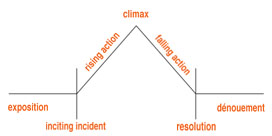|
Pre-story
|
The Open Boat
|
||||||||||
|
Stephen
|
|
The Red Badge of Courage & Other Stories
|
|||||||||
| Seven Scenes
What is the most famous ship to ever sink at sea? What happened? Have you seen the movie? Try to retell the story as just seven important scenes or events from the movie. Work with a friend and use just one sentence for each event.
Compare your Seven Scenes with other people and discuss the story. Have you ever had, or witnessed an accident in a boat? If not an accident, think about a frightening (or exciting) experience. What happened? Share your story or write a short description for another group, who can plan some questions to interview you about the event. |
|||||||||||
|
|
|||||||||||
| Sometimes life is not simple. Stories are not always easy to understand, either. Gustav Freytag was a Nineteenth Century German novelist who saw common patterns in the plots of stories and novels and developed a diagram to analyze them. He diagrammed a story's plot using a pyramid like the one shown here: | Freytag's Pyramid
1. Exposition: setting the scene. The writer introduces the characters and setting, providing description and background. 2. Inciting Incident: something happens to begin the action. A single event usually signals the beginning of the main conflict. The inciting incident is sometimes called 'the complication'. 3. Rising Action: the story builds and gets more exciting. 4. Climax: the moment of greatest tension in a story. This is often the most exciting event. It is the event that the rising action builds up to and that the falling action follows. 5. Falling Action: events happen as a result of the climax and we know that the story will soon end. 6. Resolution: the character solves the main problem/conflict or someone solves it for him or her. 7. Dénouement: (a French term, pronounced: day-noo-moh) the ending. At this point, any remaining secrets, questions or mysteries which remain after the resolution are solved by the characters or explained by the author. Sometimes the author leaves us to think about the THEME or future possibilities for the characters. You can think of the dénouement as the opposite of the exposition: instead of getting ready to tell us the story by introducing the setting and characters, the author is getting ready to end it with a final explanation of what actually happened and how the characters think or feel about it. This can be the most difficult part of the plot to identify, as it is often very closely tied to the resolution. |
||||||||||
 |
|||||||||||
| Break Down the Pyramid
Not every story you read can be diagrammed perfectly according to Freytag's Pyramid, but many can. Before we look at an example with Titanic, lets try to simplify Freytag's Pyramid by breaking it down into just three parts: beginning, middle and end. Which parts of Freytag's Pyramid would form the beginning of a story? Which parts would make up the middle? Which parts would make up the end? |
|||||||||||
|
|
|||||||||||
| To help you understand the definitions above, try to apply each
step in Freytag's Pyramid to the seven scenes you wrote down earlier.
How well do they fit? Analyze with a partner.
Next, copy Freytag's Pyramid on a piece of paper and label each point on the pyramid with these terms:
|
Jack, Rose and the other passengers wait for lifeboats.
Jack stops Rose from committing suicide. The Titanic splits in two and sinks. Elderly Rose drops the necklace into the sea and visualizes Jack as she dies peacefully. The Titanic prepares to leave England for America with Jack and Rose onboard. Rose is rescued and gives her name as Rose Dawson. As a result, Cal never finds her again. Rose's mother, her fiancé, Cal, and Cal's bodyguard try to keep Jack away from Rose as the two begin to fall in love. The ship hits an iceberg. Check your answers with the key and discuss Freytag's terms and definitions again as they relate to the plot of Titanic. |
||||||||||
| Here is one teacher's analysis of the seven most important moments in Titanic. Write each event above or below the point that it matches on Freytag's Pyramid. The order should be the same as it occurred in the film. | |||||||||||
|
|
|||||||||||